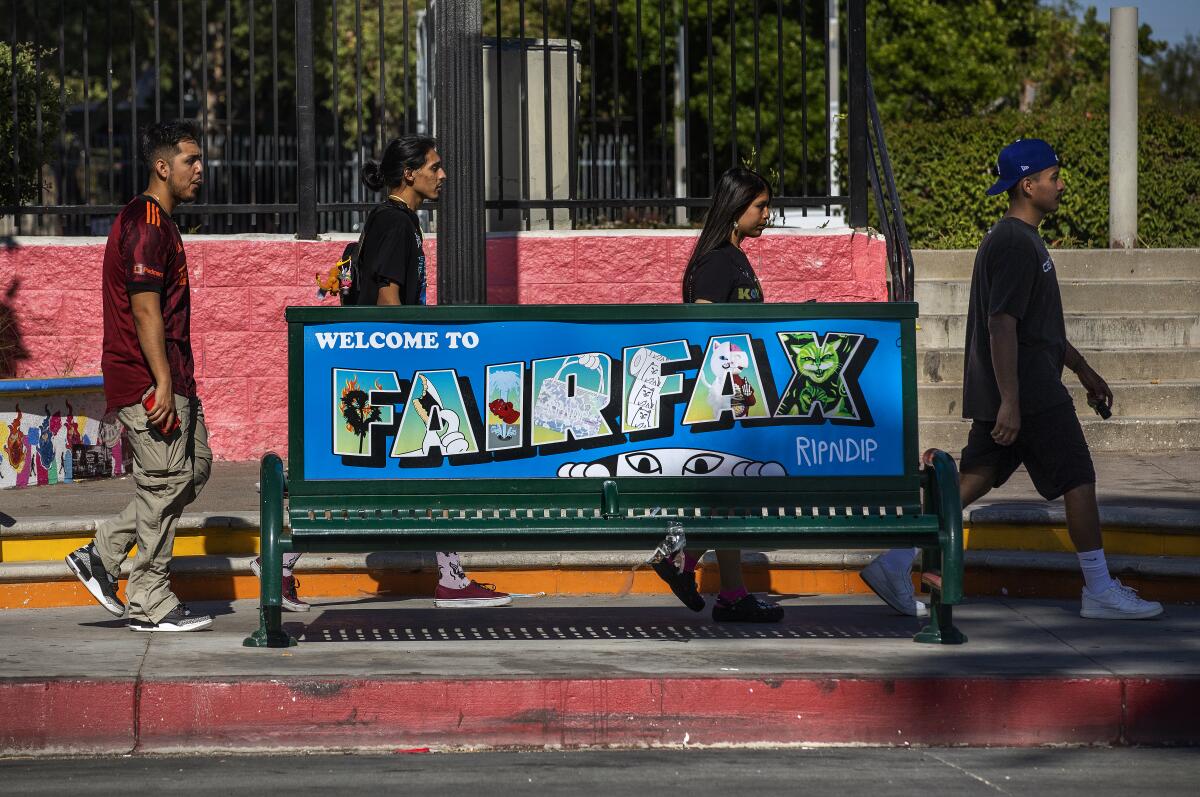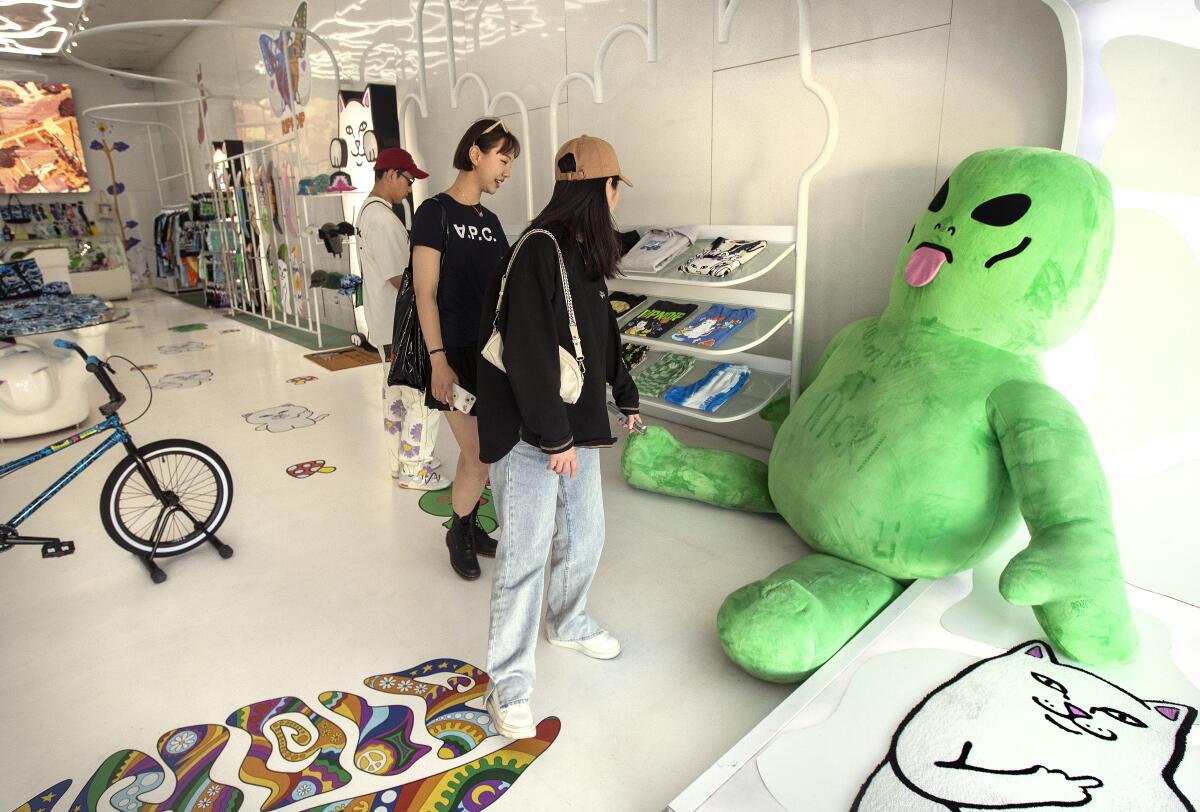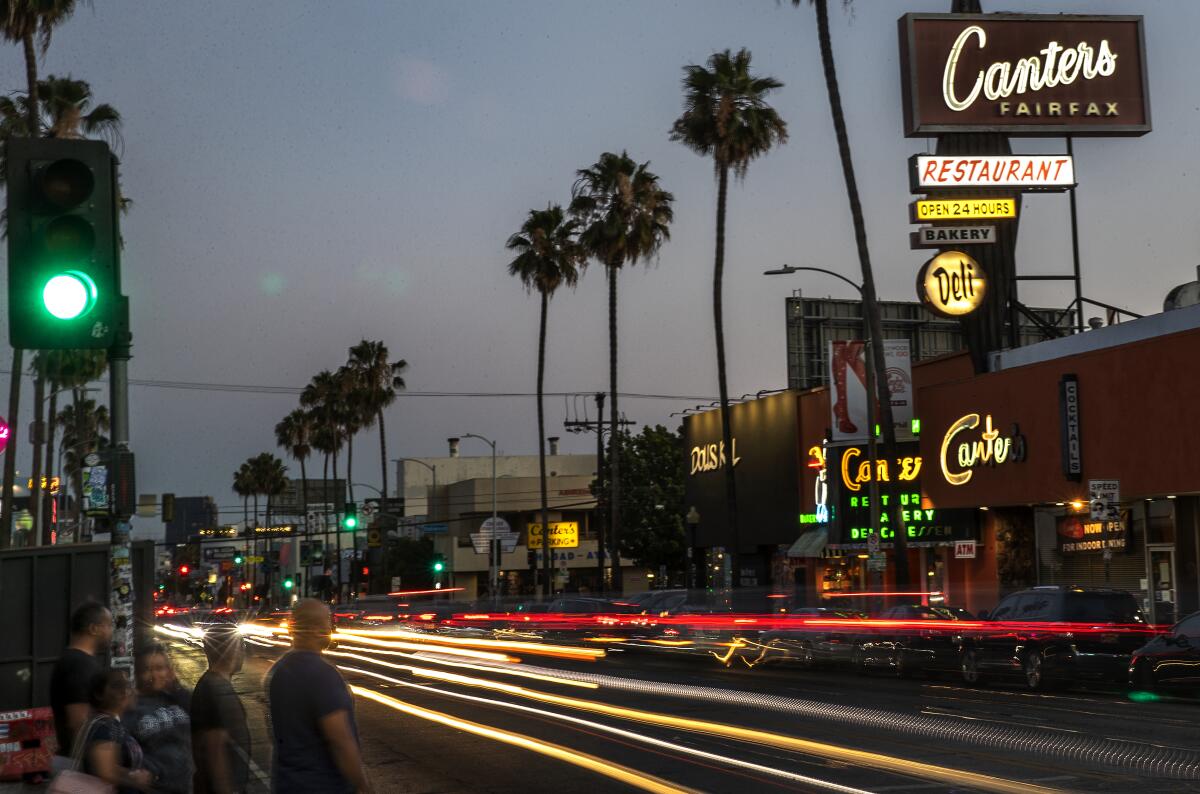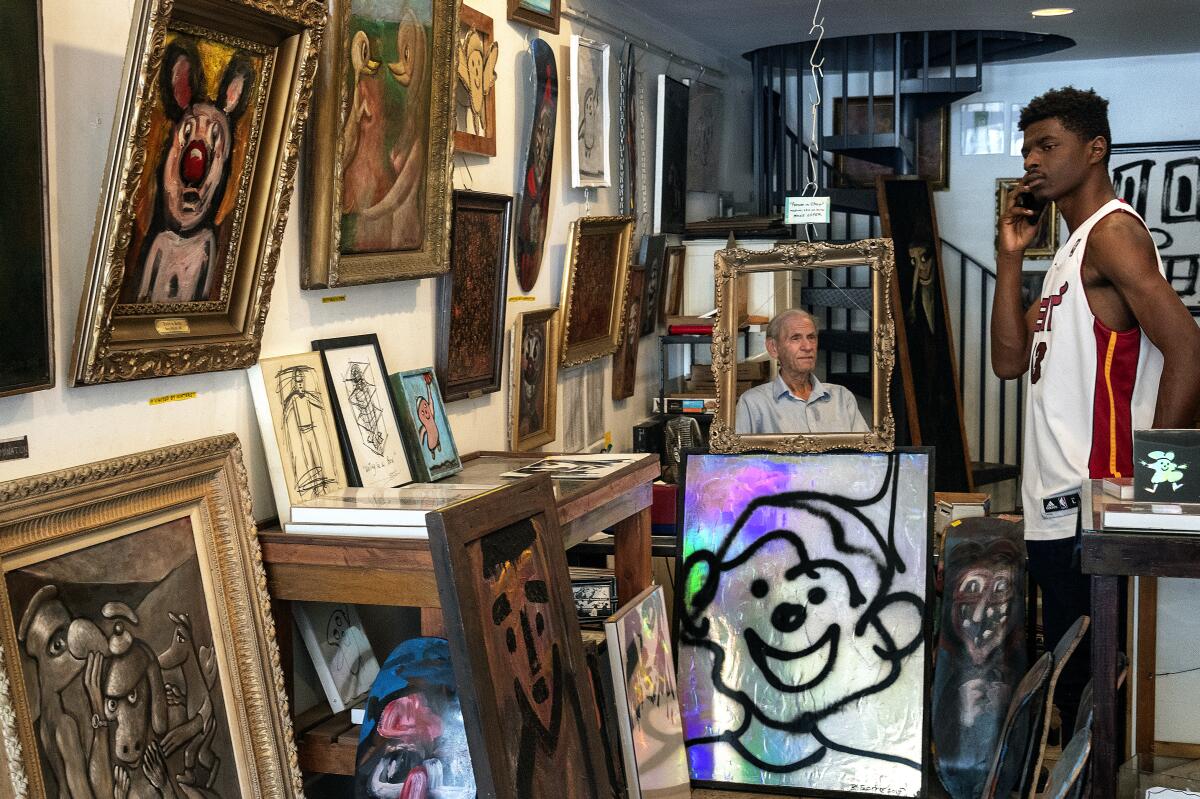The complete guide to home viewing
Get Screen Gab for everything about the TV shows and streaming movies everyone’s talking about.
You may occasionally receive promotional content from the Los Angeles Times.

On a recent Friday afternoon in the Fairfax District, the block is hot. It’s about 90 degrees outside, to start, and the second season of the neighborhood’s namesake show just dropped. Amazon’s animated series “Fairfax,” created by Matt Hausfater, Aaron Buchsbaum and Teddy Riley, is largely set on the stretch between Melrose and Beverly and satirizes the streetwear-focused “hypebeast” scene that’s centered there — a scene that one of the show’s protagonists, Dale (voiced by Skyler Gisondo), describes as being “like Hogwarts for fashion,” as he takes it all in for the first time from the back of his family’s Subaru.
At the start of Season 1, Dale is the “normcore as hell” newbie in town, oblivious to the alien world of merch drops where hats with huge holes cut into them go for $260. Soon, he’s taken under the Instagram-savvy wing of three fellow students — film buff Truman, woke activist Derica and brand-obsessed Benny — at Fairfax Middle School, a thinly veiled version of Fairfax High. (The show exists in an alternate and blindingly colorful universe in which the locales are familiar but fictional; Canter’s Deli, is replaced with “Schwimmer’s.”)
It’s a curiously vulgar and often dark comedy for a program about seventh-graders, and it’s gently critical of many aspects of the cutthroat and image-conscious scene that it’s inhabiting. The show’s version of the tastemaking store and brand Supreme, for instance, is a vibe dictatorship called Latrine. So it’s fair to ask who the show is really for — and what the real people whose lives inspire it think of their close-up. Do the hypebeasts of Fairfax like “Fairfax”? Is the block hot because of it in a good sense or bad?
The doors wouldn’t open for another hour Thursday morning, but the sartorial zealots – numbering in the hundreds – packed up their folding chairs and scanned leaked photos on Instagram, anticipating the booty to be claimed inside the Supreme clothing store.
“We watched it,” says Nico Mejia, standing with his brother, Lucas, outside Dave’s Hot Chicken. The Mejia brothers have a rolling clothing rack on the sidewalk and are selling items from their own brand — Ibis, which stands for “I believe in success.” They’ve been working for years to get it going. “The parody part of [‘Fairfax’] is a negative part that we deal with on the daily,” says Nico, “and that’s what makes it kind of hard to relate to, like, the jokes of it. Because it’s pretty accurate how it is. It really is that way.”
Nico brings up the Supreme/Latrine joke: “That’s why I’m confused on what direction they’re trying to do with the show,” he says. “Are they trying to make fun of Supreme?”
“Or are they trying to make fun of Fairfax?” Lucas jumps in.
“Or are they both the same thing?” Nico replies.

At Hall of Fame, a sportswear and fashion store, one employee is not interested in the show, but another’s ears perk up. The second clerk comes over and says she watched an episode because she heard that one of the characters had her name. “It’s, like, spelled the same way,” says Derica Compton, who genuinely does bear a resemblance to the Derica of the show. “I was tight at first. I was like, who the f— came and stole my life,” she laughs, before acknowledging that she does feel some kinship with the character: “That’s the kicker. I’m, like, wow, she’s just like me.”
Cosmic coincidence aside, Compton watched only that one episode, but not because she didn’t like it. “It had some cute little jokes,” she considers. “I think I recalled laughing.” The reason she hasn’t watched more of it, she says, is actually more of a 2022 thing: “I just have, like, the shortest attention span,” she sighs. “It’s my fault. It’s me.”
First the streaming wars. Then COVID-19. It’s been a rocky time for TV, but executives and creatives alike say adult animation is enjoying a ‘renaissance.’
Over at the AAPE store, two clerks at the counter are less generous. “I went to the premiere, and I didn’t love it, to be honest,” says an employee in his early 20s who just wanted to go by Sam. “I thought it was funny and cool, but it seemed like a little bit of, like, culture vulturing.” Sam remembers looking around at the premiere event — which was catered by Canter’s — and having a feeling that there was a gulf between the people who made the show and the people portrayed in it. “I was like, they’re different than I was,” he says, “and they’re making a show about us. I just felt like it was kind of corny in that way.” (The creators are proud to say they grew up hanging on Fairfax, but are notably in their mid-30s.)
Ky, the clerk next to Sam, hasn’t watched the show but doesn’t have a good feeling about it from seeing an ad. “It definitely did seem, like, very bandwagon,” he says. “Like, it’s the end of the ride. The ride’s over, man.”

Is Fairfax dying? Is it already dead? Jacqueline Canter, the co-owner of Canter’s, whose family has run the deli in its current spot since 1953, has a longer view of the block. “I’ve seen Fairfax change quite a bit in the 61 years that I’ve been alive,” she says over coffee at her restaurant. “It used to be mom-and-pop shops and now it’s hipsters.”
Jacqueline remembers the days when everybody spoke Yiddish on the block, including her family, and witnessed the transformation in the ’80s when it became a hangout for rockers like Guns N’ Roses. But these days, the Fairfaxians “all ride their skateboards,” she notes with a laugh. Generally, she thinks the area has improved, especially after several hundred thousand dollars was put into sprucing it up in the ’90s via the Los Angeles Neighborhood Initiative. “I like what Fairfax has become,” she says.
The complete guide to home viewing
Get Screen Gab for everything about the TV shows and streaming movies everyone’s talking about.
You may occasionally receive promotional content from the Los Angeles Times.
For an even longer historical perspective, Harry Blitzstein weighs in from his gallery, the Blitzstein Museum of Art, which features Blitzstein’s own paintings — surreal slices of modernism. “I’ve been here forever,” says Blitzstein, who is in his early 80s and has been using a space across the street from Canter’s for art since 1993. (Prior to that, it was his father’s shoe repair store.) Blitzstein says he doesn’t “totally understand the clothing stores,” but enjoys that people are still out and about on Fairfax, as opposed to many stretches in L.A., where the car is a cold, impersonal king. “I think Fairfax will only get better and better in the future,” he says.
Blitzstein was blissfully unaware of the show “Fairfax,” but Jacqueline Canter caught an episode at that Season 1 premiere event that Canter’s catered. The screening presumably included a part in the pilot where Truman explains Schwimmer’s to Dale as a place where “they got a B rating and everything is, like, 40 dollars.” (“I love it, though,” Truman adds, after the punchline.) Jacqueline didn’t take offense. “I think it’s OK to laugh at yourself,” she says. “I don’t think we should take ourselves too seriously.”

It’s undeniable that the show is on point in some of its more bitter satire — and anyway, whatever fodder the block provides for making fun is also part of its allure. (One look at the hordes swarming a corner for the gaming group FaZe Clan’s pop-up merch event should dispel any worries of Fairfax being dead, at least for now.) “That’s kind of the block in general,” says Sam, the AAPE clerk. “Like, everything’s overpriced and everyone’s mean, but there’s something about it, you know what I mean?”
In the streetwear store FourTwoFour, David Diaz points out that the street has felt a little muted since the pandemic, but remains confident in the Circle of Hype, to borrow a phrase from the show. “History tends to repeat itself,” he says. “So I feel like eventually, yeah, maybe some of the stores that were carrying the culture, maybe it dies off a little bit, but it’s bound to repeat again.”
Back out in front of Dave’s, the Mejia brothers bring up the fact that Supreme is opening a new store soon, in the space of the former Tower Records on Sunset Boulevard. They seem to be under the impression that Supreme will in turn be leaving Fairfax (though Supreme has made no such declaration — and cited a no walk-in media policy at the store for this story).
“That might be your headline: ‘Fairfax is dead!’” Lucas says. “Now the street’s gonna realize what it really is. Is it really just Supreme? Or is there more to the street, you know?”
“You remember Beanie Babies?” Nico asks, wondering how long Supreme can stay in the spotlight no matter where they are. “They’re on the same road as that.”
The complete guide to home viewing
Get Screen Gab for everything about the TV shows and streaming movies everyone’s talking about.
You may occasionally receive promotional content from the Los Angeles Times.